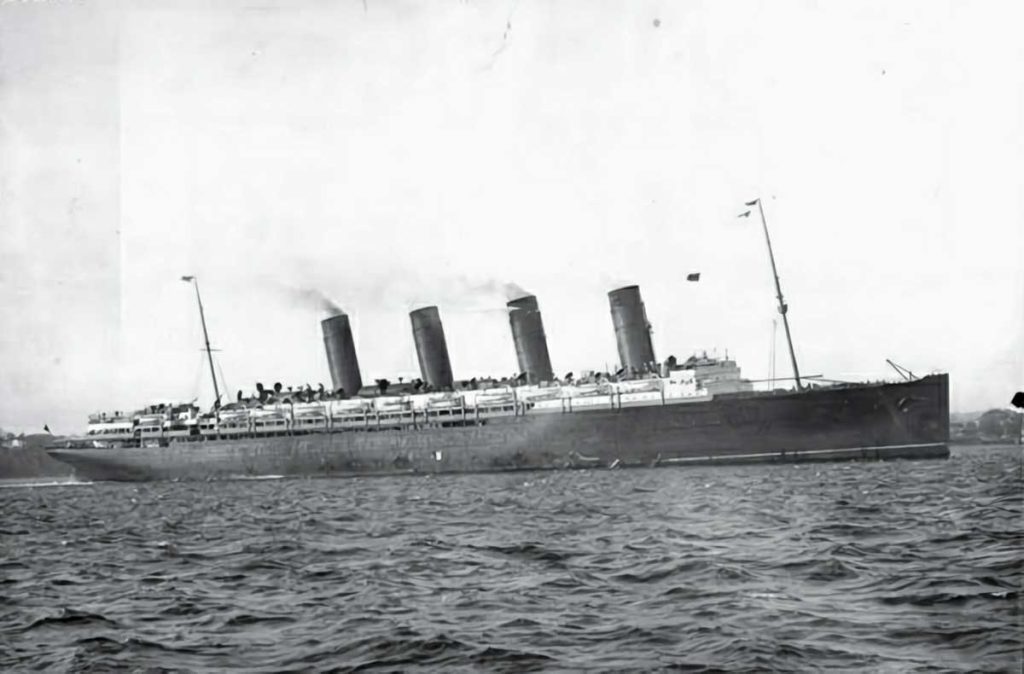Welcome to our third article in this series. The first installment discussed John Edward “Jack” Inman’s immigration to America, his employment at the Silver King Mine, and a promise to his parents that he would return to visit them when circumstances allowed. The second article described his achieving “The American Dream,” friendships forged, and his travel plans across America to board a ship to England.
Travel plans complete, Jack departed Park City on Tuesday April 20, 1915. His friends and colleagues wished him safe and easy travels. They looked forward to his return. Jack would arrive in New York City on Friday, April 23 – traveling on three different railroads to do so – where he would then travel to the docks to board a ship heading to England.
Based upon his request, a third-class ticket was reserved on the Lusitania – the Cunard Line’s premier transatlantic liner. For the privilege of sailing on this ship, Jack paid a premium – as did every other passenger regardless of their class. His fare was approximately $43 ($1,300 in 2023 money).
Jack’s visit was to be unannounced; He intended to surprise his parents. Thus, there was no communication advising them of his plans. He arranged to take a leave of absence from the Silver King Mine. At his request, The First National Bank of Park City put together a draft on his account of $494.08.

Credit: Unknown photographer, courtesy of Wikimedia Commons.
During the two years Jack chased his professional, financial, and personal goals, European powers drifted towards hostility. The insanity of war commenced on July 28, 1914. The Allied Powers (in 1915) included Great Britain, France, Russia, Italy, and Japan (The U.S. would later join them on April 6, 1917). The Central Powers encompassed the German Empire, Austria-Hungary, Bulgaria and the Ottoman Empire.
When the savagery concluded on November 11, 1918 the conflict would be known as the Great War. The combined death toll exceeded seventeen million, while those suffering life altering injuries tallied over twenty-five million. The carnage was unprecedented in human history. Technological advances, especially those associated with killing, contributed to this butchery. That technology included German U-boats, meaning the circumstances under which Jack sailed home were dramatically different from his voyage to America some years before.
In February 1915, Germany declared the waters surrounding Great Britain an active war zone. All ships flying a British flag would be subject to attack without warning. Just in case, Jack obtained a life insurance policy for $1,000 from his fraternal order, The Knights of the Maccabees. His father was named the sole beneficiary. The policy required a “proof of death” to collect. He worried little about his father collecting on the policy should he not survive the journey home. He should have worried more.
The Lusitania’s conception (1903) predated Germany’s evolution of the submarine and the torpedoes they fired. As a result, her hull possessed a fatal design flaw: longitudinal coal bunkers. Before the advent of submarine warfare, coal was considered a barrier of sorts to protect the waterline. These bunkers were essentially tunnels running along either side of the ship. Should the ship be breached below the waterline, the tunnels would flood rapidly. In such a scenario, a ship would begin to list dramatically with little time to compensate. A single torpedo strike could be lethal. It is unlikely that Jack was aware of the Lusitania’s Achilles heel.
Stay tuned for the fourth and final chapter of “The American Dream Torpedoed.”
The Park City Museum is hosting a lecture on July 10 from 5 to 6 p.m. titled “Daly Judge Tunnel Water Supply and the Olympics,” given by mining consultant former University of Utah mining engineering professor Mike Nelson. The lecture will take place at the Museum’s Education and Collections Center at 2079 Sidewinder Drive.